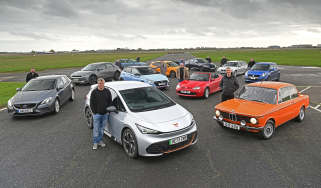Rover 25
It has been a bumper year of new model launches from MG Rover, with every car in the firm's line-up receiving a nip and tuck to try and keep the marque competitive until an all-new range appears on the horizon.
Don't be fooled into thinking the 25 is all-new - it's a mildly revised version of a car that's been around for a while. So it still falls behind in many areas, with a cramped cabin and ageing engines. That said, its keen pricing, generous spec and peppy performance will make it attractive to anyone seeking a no-nonsense family hatchback on a supermini budget.
It has been a bumper year of new model launches from MG Rover, with every car in the firm's line-up receiving a nip and tuck to try and keep the marque competitive until an all-new range appears on the horizon.
The latest vehicle to get fresh styling and a revised interior is the company's best-seller - the 25. Its appear- ance falls in line with the facelifts given to its 45 and 75 stablemates. Gone are the twin headlamps and ornate chrome grille, to be replaced by clear-lens lights and a less fussy front end.
The look isn't as successful as on the larger models, though, with wide panel gaps and a deep front bumper that appears a little too large for the car. Other changes include body-coloured side rubbing strips and a new design for the alloy wheels, along with a bigger, simplified logo on the nose.
At the rear, both the bumper and tailgate have been restyled. The Rover badge now runs across the width of the bootlid, while the number plate has been moved lower down to sit in a cut-out in the bumper.
We have to take issue with the new tailgate, though. The external latch has been removed, leaving the remote keyfob plipper as the only way of unlocking the bootlid. The lack of a release lever in the cabin is frustrating, making opening the loadbay unnecessarily fiddly.
Where the facelift is most successful, though, is inside. The 25 gets a completely revised dashboard - with four circular air vents replacing the old model's tacky plastic ones - while the quality of the materials used is far better. The layout is more logical, too, with a central bank of switches instead of the previous car's rather haphazard arrangement, and improved column stalks finished in less shiny plastic.
In addition, there is a new centre console, which runs along the floor past the gearlever. This incorporates the electric window switches - a feature taken from the Streetwise urban SUV which was launched last year.
We drove the mid-range 25 SEi, which comes with air-conditioning, 16-inch alloy wheels, Trafficmaster congestion alert and a choice of burr walnut, black oak or light oak wood trim in the centre of the dashboard. At £11,945, it seems a good-value package, priced to match rivals' smaller models such as the Ford Fiesta Ghia and Volkswagen Polo FSI SE.
Yet despite its keen value, the 25 does feel its age. Rover has improved the clutch and throttle responses, but even so, the car still lacks the smoothness of most competitors, while some of the controls are heavy and the driving position awkward.
The performance from the proven K Series powerplant is still impressive for a 1.4-litre motor, yet refinement is not great, with lots of engine noise at high revs plus plenty of tyre roar and wind whistle while cruising.
Dynamically, the Rover is well balanced, with a tidy chassis and responsive steering, but the ride suffers badly on poor surfaces and the brakes lack feel. The vehicle's basic structure also counts against it. It might be bigger on the outside than many supermini competitors, but the 25 is surprisingly cramped inside, with limited rear legroom and a narrow cabin.
That said, the boot is generously sized and the new cabin layout offers plenty of storage for personal items. The rear seat doesn't fold fully flat, though, limiting the height of any large objects loaded into the boot.
If anything, the 25 is proof that there's life in the old dog yet - and the Rover's keen pricing will no doubt attract bargain-hunting buyers. However, the British manufacturer really needs to revise its model line-up with entirely new cars - and not facelifts - if it's to expect a growth in European sales.



